Always New: The Posters of Jules Chéret
Reviewed by Karen L. CarterKaren L. Carter
Professor of Art History, Kendall College of Art and Design, Ferris State University
Email the author: karencarter[at]ferris.edu
Citation: Karen L. Carter, exhibition review of Always New: The Posters of Jules Chéret, Nineteenth-Century Art Worldwide 21, no. 3 (Autumn 2022), https://doi.org/10.29411/ncaw.2022.21.3.26.
This work is licensed under a Creative Commons Attribution-NonCommercial 4.0 International License  unless otherwise noted.
unless otherwise noted.
Your browser will either open the file, download it to a folder, or display a dialog with options.
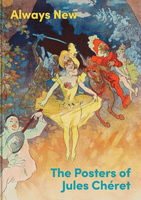
Always New: The Posters of Jules Chéret
Milwaukee Art Museum, Milwaukee
June 3–October 16, 2022
Catalogue:
Nikki Otten, ed.,
Always New: The Posters of Jules Chéret, Selections from the James and Susee Wiechmann Collection at the Milwaukee Art Museum.
Milwaukee: Milwaukee Art Museum, 2022.
240 pp.; 153 color and 11 b&w illus.; notes; list of works in the Wiechmann Collection;
bibliography.
$49.95 (hardcover); $39.95 (softcover)
ISBN: 978–1–938885–16–7
ISBN: 978–1–938885–17–4
The 1880s and 1890s are often referred to as a Golden Age for the poster in France. Color lithograph posters flourished due to changes in the press laws that liberalized poster distribution, new technological advances in printing that made it easier and cheaper to print posters, and the emergence of a consumer culture that demanded images to help market goods to the public. In these decades, critics described the advertising poster as ubiquitous and claimed it represented a uniquely modern, urban form of culture that captured the very essence of the Belle Époque in its representations of the entertainments and spectacles that were on offer throughout the city.
The poster designer who received the most critical attention at this time was the Frenchman Jules Chéret; most of it was overwhelmingly positive. After apprenticing at a young age in a printing company in Paris and then working in England to perfect his skills at color lithography, Chéret moved back to Paris in the 1860s and was soon recognized for his skill in poster design. He gained recognition because of his stylistic flair and his prominent signatures on his posters. The year 1889 marked a breakthrough year for Chéret when he was inducted into the Legion of Honor, won a gold medal at the 1889 Exposition Universelle in Paris, and garnered his own solo exhibition that resulted in wide-ranging critical acclaim.
Now Chéret appears to be finally gaining recognition for his colorful posters in the United States. Always New: The Posters of Jules Chéret, an exhibition held at the Milwaukee Art Museum (MAM), is the first devoted exclusively to Chéret’s posters in the United States. The show features over one hundred posters, drawings, and prints from the James and Susee Wiechmann Collection of works on paper, which was recently donated to the Milwaukee Art Museum and consists mainly of works by Chéret. According to the exhibition curator, Nikki Otten, this gift leaves the Milwaukee Art Museum with the largest collection of Chéret’s posters in the United States.
The size and scope of this exhibition is remarkable considering that he is not a well-known figure in the United States and that most of his output consisted of commercial advertising. Although Chéret was one of the most prolific and critically praised poster designers in the 1880s and 1890s, he was neglected as a topic of art historical study after his death in 1932, especially in English language scholarship. Thirty years ago, there were few publications devoted to him. Despite a Chéret biography written in 1930 by Camille Mauclair in French and a catalogue raisonné of his posters compiled by the American art dealer Lucy Broido in 1980, he was usually mentioned in art historical scholarship, or more accurately, in exhibition catalogues, as an early designer of color lithographed posters whose reputation was easily eclipsed by more important fin-de-siècle artists such as Henri de Toulouse-Lautrec, Maurice Denis, Pierre Bonnard, and other artists who tried their hands at poster design following Chéret’s success and notoriety.[1] His background in commercial lithography, rather than the fine arts, appears to have been an obstacle for him to be considered seriously, especially in comparison to some of the giants of the French lithographic revival, in particular Toulouse-Lautrec.[2]
His reputation began to change in the 1980s and 1990s with the publication of several books and essays devoted to French fin-de-siècle posters, some of which focused on Chéret in particular.[3] More recently, an updated catalogue raisonné of Chéret’s posters and decorative art designs was published in conjunction with a major exhibition organized in 2010 by the Musée des Arts Décoratifs (Paris) and the Bibliothèque National de France (Paris). The exhibition catalogue The Belle Epoque of Jules Chéret marked a consideration of Chéret, not merely as an adjunct to the prints and paintings of other artists, but as an important artist in his own right.[4] Interest in Chéret has no doubt been helped by the broader range of visual culture studied in the humanities after the “visual turn.” New approaches have not dismissed the poster because of its commercial function or lowly artistic status. The scholarship of historian Vanessa Schwartz, for example, examined neglected historical artifacts such as wax works, early film, and posters.[5] Schwartz and art historian Jeannene Przyblyski announced in the introduction to their anthology, The Nineteenth-Century Visual Culture Reader, the need for a departure from focusing only on art with a capital “A.”[6]
The Always New exhibition offers its audiences an opportunity to appreciate posters from the late nineteenth century both as art and as traces of contemporaneous forms of entertainment, leisure, travel, shopping, fashion, and the press. The exhibition spans six large galleries; this much space is needed due to the size of posters from this era, some of which measure almost eight feet in height. Each section of the exhibition is divided into specific themes for grouping Chéret’s posters: “Novelty Acts: Cabaret Performers and Spectacle,” “La Mode de Paris: Fashion and Department Stores,” “The Latest Page Turner: The Press and Serialized Novels,” “Voyage: Real and Imagined Travel,” and “To Your Health: Consumables.”
The first gallery the visitor enters is a prelude to the exhibition with two posters that advertise companies responsible for distributing publicity, a painting by Louis-Robert Carrier-Belleuse that represents Chéret’s posters in the streets, and early examples of lithography produced by Chéret for the French-born, London-based parfumier and cosmetics entrepreneur, Eugéne Rimmel. Chéret worked for Rimmel in London, where he mastered lithographic printing using the latest equipment, and Rimmel’s patronage helped Chéret’s career in his formative years.
In the “Novelty Acts” section, the visitor can see many wonderful smaller posters for Parisian cabarets from the early period of Chéret’s work in Paris in the 1870s and 1880s (fig. 1), as well as larger, full color posters for the Musée Grévin (1891, fig. 2). Some breathtaking examples in this gallery are Chéret’s posters for the Moulin Rouge (1889) and the Palais de Glace Champs Elysées (1894, fig. 3).
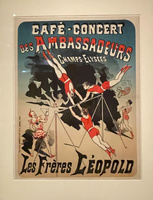
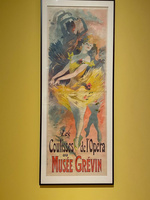
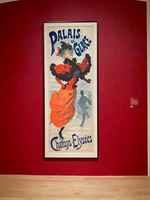
The “La Mode de Paris” gallery, featuring Chéret’s work for department stores and fashion, is probably the most original part of the show because these posters are not always seen in exhibitions. Instead of the brightly colored, dynamic designs of Chéret’s entertainment posters (figs. 2, 3), we see more muted and “pedestrian” examples of posters that presumably represented the ordinary consumer (fig. 4). Although they may seem atypical for Chéret, these advertisements for the newly emerging department stores in Paris were an important part of his output throughout his career. The next gallery, “The Latest Page Turner,” is dedicated to Chéret’s posters for the French press (fig. 5). Many of these examples are also not as well known, such as the posters that advertised sensationalist serialized novels in the newspapers Le XIXe Siècle (The 19th Century) and Journal du Dimanche (The Sunday Newspaper). The section of travel advertisements (“Voyages”) features posters for destinations such as Trouville and Auvergne, as well as imagined voyages in panoramas and exotic performances in the Hippodrome and Folies-Bergère. The last space of the exhibition displays posters for “consumables,” everyday products from soap to lamp oil.
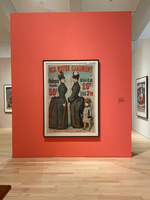
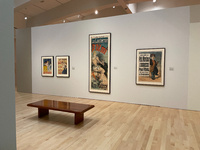
Otten has employed different techniques to suggest the spaces where the posters were displayed—the streets, kiosks, and newsstands—as well as the spaces of modern Paris, such as railroad stations and department stores. Large period photographs of posters in the streets (fig. 6) give visitors a sense of the immense displays of commercial advertising in fin-de-siècle Paris. Photographs of arcades, newspapers, and railway stations are combined with mockups of shop signs and architectural constructions to suggest urban spaces: an arcade, a structure that mimics a railway station (fig. 7), and a faux streetlamp with a newspaper seller’s stall are some of the inventive designs used to transport visitors to this historical period. Music and sounds are played in galleries to reinforce this cultural context for posters. For example, when entering the “Novelty Acts” gallery, the visitor hears a recording of a cabaret performance. The space of the “Voyage” gallery is filled with the sound of trains entering a station. These effects were important to provide an experience that is visual and auditory and to some extent spatial.
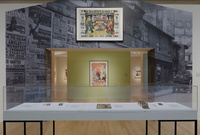
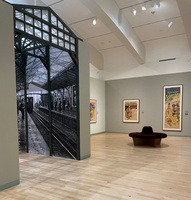
By focusing on Chéret, Always New gives us the rare opportunity to delve more deeply into his posters and get a better sense of his development in terms of design, printing techniques, and approach to color. The exhibition also reflects a very careful cataloguing of the Wiechmann Collection. The wall labels and catalogue include detailed information about each poster’s content, and in order to make the material accessible to a US audience, all of the titles and most of the posters’ texts have been translated from French into English. Just as important, most of the posters shown from the Wiechmann Collection are in pristine condition, which is extraordinary considering that fin-de-siècle posters were printed on flimsy paper. Nineteenth-century commentators often decried the short life span of posters, whose colors faded and papers were easily torn to shreds in a matter of hours after having been pasted on walls. Except for a few large posters that bear some minor crease marks, the entire collection boasts posters in better condition than many of those found in larger French collections. Seeing so many of Chéret’s posters together with their vivid colors and dynamic draughtsmanship is an exceptional experience.
The catalogue that accompanies the Always New exhibition includes essays by Otten, Ruth E. Iskin, and Virginie Vignon. All of the posters exhibited in the galleries are reproduced in the catalogue in full-page color plates with translations of the titles and short explanations of the posters’ content. Short essays introduce each thematic section found in the exhibition. A complete list of the works in the James and Susee Wiechmann Collection is included, along with a short bibliography of sources on Chéret and nineteenth-century French posters.
Otten’s essay, “Lithographic Monuments: The Ephemeral as Modern in Chéret’s Posters,” offers an excellent introduction to the subject matter of the exhibition. She emphasizes the importance of Chéret for the development of the modern poster and the primacy of Paris as a major center of visual culture. Relying on commentary written about posters at the time, “Lithographic Monuments” makes the argument that while posters are ephemeral objects, they transcend their historical period and give us a glimpse into the cultural mores of the time. In fact, according to Otten, the modern poster can be regarded as a distilled image of the eternal (à la Baudelaire) that transcends its original function of advertising and is therefore “always new” (15).
Iskin’s contribution to the catalogue, “Chéret’s Department Store Fashion Poster: Marketing to Women Consumers,” relies on her previous scholarship to discuss the imagery of Chéret’s posters for fashion and department stores.[7] As noted earlier, Chéret’s posters in this vein (see fig. 4) do not resemble his more vivacious and lively posters for entertainment, leisure, or travel and for that reason, they have received scant scholarly attention. By primarily making visual comparisons of fashion plates and posters, Iskin argues that Chéret’s posters for women’s fashions were representing more accurately the consumer for the ready-to-wear sold in the newly emerging department stores. Contrasting Chéret’s “artistic” posters, which featured the sexually alluring chérette (named after the artist) with his “commercial” posters, which represented the “Parisian,” Iskin argues that Chéret followed the example of illustrations in fashion plates to attract middle-class female consumers. It would have been helpful if Iskin had discussed with more nuance the categories she used in her essay, such as the binary of “artistic” and “commercial” posters. Chéret’s posters—and most posters of this period—were commercial in function. The separation of “artistic” from “commercial” posters was a paradigm initiated by poster critics in the 1890s to elevate the status of advertising posters and designate examples worthy of appreciation and collecting.[8] Iskin could have equally considered the possibility that Chéret’s department store posters were based on simpler illustrations that were published in the classified sections of newspapers in addition to the imagery of fashion plates.
The last essay in the catalogue, “Jules Chéret and the Color Poster in France: Design and Printing in the Late Nineteenth Century,” by Vignon (and translated from French to English by Jeanine Herman), makes available to English-language audiences new research about Chéret’s lithographic printing company. Vignon completed her dissertation on the topic of Chéret’s industrial printing in 2007 and published a short exhibition catalogue on the same topic in 2015.[9] Drawing on primary documents and archival sources in Paris, Vignon examines the founding, financial difficulty, and eventual decline of Chéret’s lithographic printing companies. According to Vignon, “A close look at the successive records of the creation and dissolution of Chéret’s companies highlights the financial instability that he regularly encountered in undertaking professional projects” (53). After his last printing company was purchased by Chaix printing house, Chéret served as its artistic director from 1881 to 1910. The essay reviews Chéret as an entrepreneur and summarizes information about the number of his posters that his firms (and later Chaix) printed as well as giving a detailed chronology of the various companies owned by Chéret between 1886 and 1881. Vignon’s essay indicates that despite Chéret’s importance as a poster designer, his popularity among critics and collectors, and his recognized pioneering work in illustrated advertising, he was unable to maintain his own lithography business in the face of fierce competition from larger and more established firms such as Champenois and Lemercier. She maintains that in spite of the popularity of posters in the late nineteenth century, advertisements in the press were actually more prevalent and proved to be cheaper due to the tax stamps required in France for posters intended for public display. Vignon’s essay documents the business side of French commercial lithographic poster printing which, unlike histories of the lithographic process for fine art printing, has until recently been fairly neglected.[10] This particular essay, nonetheless, probably holds greater interest for the specialist rather than a general reader and could have benefitted from a broader discussion about poster printing in France.
Always New: The Posters of Jules Chéret is overall a successful exhibition that informs visitors about the cultural phenomenon of color lithographed posters. In a larger cultural sense, then, commercial posters are celebrated as contributing to the visuality of Parisian life in the late nineteenth century. One minor issue with the exhibition is that the visitor cannot make comparisons with posters or prints produced during the era by other artists, which would have allowed Chéret to be placed within an entire generation of image-makers. The inclusion of posters, ephemera, and book illustration created by French, European, or North American designers during the same period could have provided an expanded scope for the show. Even if the focus were only on Paris, many French and foreign designers (avant-garde and more ordinary designers working in the print trades) could have been included to present a broadened scope of late nineteenth-century visual culture in Paris.
Notes
[1] Camille Mauclair, Jules Chéret (Paris: M. Le Garrec, 1930); Lucy Broido, The Posters of Jules Chéret (New York: Dover, 1980).
[2] Chéret’s posters are also discussed in art historical scholarship due to their influence on postimpressionist painter Georges Seurat. See Robert Herbert, “Seurat and Jules Chéret,” Art Bulletin, no. 40 (June 1958): 156–58 and Ségolène Le Men, Seurat et Chéret: le peintre, le cirque et l’affiche (Paris: CNRS Editions, 1994).
[3] Phillip Dennis Cate and Sinclair Hitchings, The Color Revolution: Color Lithography in France 1890–1900, exh. cat. (New Brunswick, NJ: Rutgers University Art Gallery; Boston: Boston Public Library, 1978); Phillip Dennis Cate, “The French Poster, 1868–1900,” in American Posters of the 1890s in the Metropolitan Museum of Art, exh. cat. (New York: Harry Abrams, 1987); Bradford Ray Collins, “The Poster as Art: Jules Chéret and the Struggle for Equality of the Arts in Late Nineteenth-Century France,” Design Issues 2, no. 1 (Spring 1985): 41–50.
[4] Réjane Bargiel and Ségolène Le Men, eds., La Belle Époque de Jules Chéret: de l’affiche au décor, exh. cat. (Paris: Les Arts Décoratifs and Bibliothèque Nationale de France, 2010).
[5] See especially Marcus Verhagen, “The Poster in Fin-de-siècle Paris: The Mobile and Degenerate Art,” in Cinema and the Invention of Modern Life, ed. Leo Charney and Vanessa Schwartz (Berkeley: University of California Press, 1996) and Vanessa Schwartz, Spectacular Realities: Early Mass Culture in Fin-de-Siècle Paris (Berkeley, CA: University of California Press, 1998).
[6] “Visual culture can be defined by its objects of study, which are examined not for their aesthetic value per se but for their meaning as modes of making images and defining visual experience in particular historical contexts.” Vanessa Schwartz and Jeanne Pryzblyski, eds., The Nineteenth-Century Visual Culture Reader (New York and London: Routledge, 2004), 6–7.
[7] Ruth Iskin, Modern Women and Parisian Consumer Culture in Impressionist Painting (Cambridge and New York: Cambridge University Press, 2007) and The Poster: Art, Advertising, Design and Collecting, 1860s–1900s (Hanover, NH: Dartmouth College Press, 2014).
[8] Lucien Muhlfield, “L’affichage moderne,” in Badauderies parisiennes ou Les Rassemblements: Physiologies de la rue (Paris: Henry Floury, 1896), 71.
[9] Virginie Vignon, Jules Chéret, créateur d’une industrie publicitaire (1836–1932), Ph.D. diss. (Université de Paris X Nanterre, 2007) and Jules Chéret et l’âge de l’imprimé, l’image dans tous les états, exh. cat. (Musée Roybert Fould and Somogy Editions d’Art, 2015).
[10] For an overview of color printing in nineteenth-century France, see especially Laura Kalba, Color in the Age of Impressionism: Technology, Commerce, and Art (University Park, PA: Penn State University Press, 2017). Another source that examines Chéret’s early career is Anne-Marie Sauvage, “Le débuts de Jules Chéret jusqu’à 1881,” in La Belle Époque de Jules Chéret, ed. Réjane Bargiel and Ségolène Le Men (Paris: Les Arts Décoratifs, 2010), 34–49.